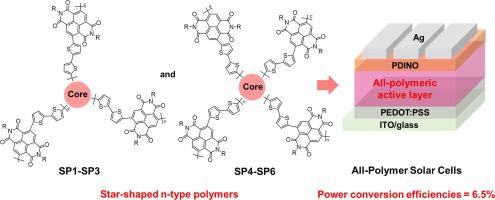当前位置:
X-MOL 学术
›
Sol. Energy
›
论文详情
Our official English website, www.x-mol.net, welcomes your feedback! (Note: you will need to create a separate account there.)
Core unit engineering of star-shaped acceptor polymers for all-polymer solar cells
Solar Energy ( IF 6.7 ) Pub Date : 2020-09-01 , DOI: 10.1016/j.solener.2020.06.092 Mingde Ma , Qing Ji , Luqi Yin , Kai Lin , Guanzhao Wen , Yunxiang Xu , Nan Zhang , Geng Dong , Liangmin Yu , Wei Zhang , Xiaofeng Xu
Solar Energy ( IF 6.7 ) Pub Date : 2020-09-01 , DOI: 10.1016/j.solener.2020.06.092 Mingde Ma , Qing Ji , Luqi Yin , Kai Lin , Guanzhao Wen , Yunxiang Xu , Nan Zhang , Geng Dong , Liangmin Yu , Wei Zhang , Xiaofeng Xu

|
Abstract Growing efforts have been devoted to developing electron-acceptor polymers as alternatives to fullerene derivatives and realizing high-performance all-polymer solar cells (all-PSCs). Until recently, the majority of acceptor polymers used in all-PSCs are constructed with linear conjugated backbones. Star-shaped conjugated polymers, featuring three or more conjugated arms radiating like spokes from a central axle, are exceptional and providing a fascinating area of study. In this concept, the shapes of polymers can be extended to second and third (2D and 3D) dimensions and the degree of intermolecular interaction can be substantially modulated. This property is suggested to prevent the aggregation of some conventional acceptor polymers and optimize the blend morphology in all-PSCs. However, there is a dearth of systematic studies in this area. To this end, we synthesize six star-shaped acceptor polymers, in which three or four conjugated arms based on naphthalene diimide (NDI) and bithiophene share a specific core unit. The different shapes and conjugation length generated by core units modulate the molecular weights and photophysical properties of the star-shaped polymers, and the miscibility with the donor polymer in all-polymeric blends. Three of the six all-PSCs attain good power conversion efficiencies (PCEs) over 6.0% and the best PCE is 6.5%. This work discloses the synergetic effects generated by the star-shaped acceptor polymers on the performance of the all-PSCs, and also highlights an promising avenue for developing high-performing acceptor polymers by using a star-shape strategy.
中文翻译:

全聚合物太阳能电池星形受体聚合物的核心单元工程
摘要 越来越多的努力致力于开发电子受体聚合物作为富勒烯衍生物的替代品,并实现高性能全聚合物太阳能电池 (all-PSC)。直到最近,全 PSC 中使用的大多数受体聚合物都是用线性共轭骨架构建的。星形共轭聚合物具有三个或更多共轭臂,像辐条一样从中轴辐射,非常特别,提供了一个引人入胜的研究领域。在这个概念中,聚合物的形状可以扩展到第二和第三(2D 和 3D)维度,并且可以显着调节分子间相互作用的程度。建议使用此特性来防止某些传统受体聚合物的聚集并优化所有 PSC 中的共混物形态。然而,缺乏这方面的系统研究。为此,我们合成了六个星形受体聚合物,其中三个或四个基于萘二亚胺 (NDI) 和联噻吩的共轭臂共享一个特定的核心单元。核心单元产生的不同形状和共轭长度调节星形聚合物的分子量和光物理性质,以及与全聚合物共混物中供体聚合物的混溶性。六个全 PSC 中的三个实现了超过 6.0% 的良好功率转换效率 (PCE),最佳 PCE 为 6.5%。这项工作揭示了星形受体聚合物对全 PSCs 性能产生的协同效应,也强调了使用星形策略开发高性能受体聚合物的有前途的途径。我们合成了六个星形受体聚合物,其中三个或四个基于萘二亚胺 (NDI) 和联噻吩的共轭臂共享一个特定的核心单元。核心单元产生的不同形状和共轭长度调节星形聚合物的分子量和光物理性质,以及与全聚合物共混物中供体聚合物的混溶性。六个全 PSC 中的三个实现了超过 6.0% 的良好功率转换效率 (PCE),最佳 PCE 为 6.5%。这项工作揭示了星形受体聚合物对全 PSCs 性能产生的协同效应,也强调了使用星形策略开发高性能受体聚合物的有前途的途径。我们合成了六个星形受体聚合物,其中三个或四个基于萘二亚胺 (NDI) 和联噻吩的共轭臂共享一个特定的核心单元。由核心单元产生的不同形状和共轭长度调节星形聚合物的分子量和光物理性质,以及与全聚合物共混物中供体聚合物的混溶性。六个全 PSC 中的三个实现了超过 6.0% 的良好功率转换效率 (PCE),最佳 PCE 为 6.5%。这项工作揭示了星形受体聚合物对全 PSCs 性能产生的协同效应,也强调了使用星形策略开发高性能受体聚合物的有前途的途径。其中三个或四个基于萘二亚胺 (NDI) 和联噻吩的共轭臂共享一个特定的核心单元。核心单元产生的不同形状和共轭长度调节星形聚合物的分子量和光物理性质,以及与全聚合物共混物中供体聚合物的混溶性。六个全 PSC 中的三个实现了超过 6.0% 的良好功率转换效率 (PCE),最佳 PCE 为 6.5%。这项工作揭示了星形受体聚合物对全 PSCs 性能产生的协同效应,也强调了使用星形策略开发高性能受体聚合物的有前途的途径。其中三个或四个基于萘二亚胺 (NDI) 和联噻吩的共轭臂共享一个特定的核心单元。核心单元产生的不同形状和共轭长度调节星形聚合物的分子量和光物理性质,以及与全聚合物共混物中供体聚合物的混溶性。六个全 PSC 中的三个实现了超过 6.0% 的良好功率转换效率 (PCE),最佳 PCE 为 6.5%。这项工作揭示了星形受体聚合物对全 PSCs 性能产生的协同效应,也强调了使用星形策略开发高性能受体聚合物的有前途的途径。核心单元产生的不同形状和共轭长度调节星形聚合物的分子量和光物理性质,以及与全聚合物共混物中供体聚合物的混溶性。六个全 PSC 中的三个实现了超过 6.0% 的良好功率转换效率 (PCE),最佳 PCE 为 6.5%。这项工作揭示了星形受体聚合物对全 PSCs 性能产生的协同效应,也强调了使用星形策略开发高性能受体聚合物的有前途的途径。核心单元产生的不同形状和共轭长度调节星形聚合物的分子量和光物理性质,以及与全聚合物共混物中供体聚合物的混溶性。六个全 PSC 中的三个实现了超过 6.0% 的良好功率转换效率 (PCE),最佳 PCE 为 6.5%。这项工作揭示了星形受体聚合物对全 PSCs 性能产生的协同效应,也强调了使用星形策略开发高性能受体聚合物的有前途的途径。
更新日期:2020-09-01
中文翻译:

全聚合物太阳能电池星形受体聚合物的核心单元工程
摘要 越来越多的努力致力于开发电子受体聚合物作为富勒烯衍生物的替代品,并实现高性能全聚合物太阳能电池 (all-PSC)。直到最近,全 PSC 中使用的大多数受体聚合物都是用线性共轭骨架构建的。星形共轭聚合物具有三个或更多共轭臂,像辐条一样从中轴辐射,非常特别,提供了一个引人入胜的研究领域。在这个概念中,聚合物的形状可以扩展到第二和第三(2D 和 3D)维度,并且可以显着调节分子间相互作用的程度。建议使用此特性来防止某些传统受体聚合物的聚集并优化所有 PSC 中的共混物形态。然而,缺乏这方面的系统研究。为此,我们合成了六个星形受体聚合物,其中三个或四个基于萘二亚胺 (NDI) 和联噻吩的共轭臂共享一个特定的核心单元。核心单元产生的不同形状和共轭长度调节星形聚合物的分子量和光物理性质,以及与全聚合物共混物中供体聚合物的混溶性。六个全 PSC 中的三个实现了超过 6.0% 的良好功率转换效率 (PCE),最佳 PCE 为 6.5%。这项工作揭示了星形受体聚合物对全 PSCs 性能产生的协同效应,也强调了使用星形策略开发高性能受体聚合物的有前途的途径。我们合成了六个星形受体聚合物,其中三个或四个基于萘二亚胺 (NDI) 和联噻吩的共轭臂共享一个特定的核心单元。核心单元产生的不同形状和共轭长度调节星形聚合物的分子量和光物理性质,以及与全聚合物共混物中供体聚合物的混溶性。六个全 PSC 中的三个实现了超过 6.0% 的良好功率转换效率 (PCE),最佳 PCE 为 6.5%。这项工作揭示了星形受体聚合物对全 PSCs 性能产生的协同效应,也强调了使用星形策略开发高性能受体聚合物的有前途的途径。我们合成了六个星形受体聚合物,其中三个或四个基于萘二亚胺 (NDI) 和联噻吩的共轭臂共享一个特定的核心单元。由核心单元产生的不同形状和共轭长度调节星形聚合物的分子量和光物理性质,以及与全聚合物共混物中供体聚合物的混溶性。六个全 PSC 中的三个实现了超过 6.0% 的良好功率转换效率 (PCE),最佳 PCE 为 6.5%。这项工作揭示了星形受体聚合物对全 PSCs 性能产生的协同效应,也强调了使用星形策略开发高性能受体聚合物的有前途的途径。其中三个或四个基于萘二亚胺 (NDI) 和联噻吩的共轭臂共享一个特定的核心单元。核心单元产生的不同形状和共轭长度调节星形聚合物的分子量和光物理性质,以及与全聚合物共混物中供体聚合物的混溶性。六个全 PSC 中的三个实现了超过 6.0% 的良好功率转换效率 (PCE),最佳 PCE 为 6.5%。这项工作揭示了星形受体聚合物对全 PSCs 性能产生的协同效应,也强调了使用星形策略开发高性能受体聚合物的有前途的途径。其中三个或四个基于萘二亚胺 (NDI) 和联噻吩的共轭臂共享一个特定的核心单元。核心单元产生的不同形状和共轭长度调节星形聚合物的分子量和光物理性质,以及与全聚合物共混物中供体聚合物的混溶性。六个全 PSC 中的三个实现了超过 6.0% 的良好功率转换效率 (PCE),最佳 PCE 为 6.5%。这项工作揭示了星形受体聚合物对全 PSCs 性能产生的协同效应,也强调了使用星形策略开发高性能受体聚合物的有前途的途径。核心单元产生的不同形状和共轭长度调节星形聚合物的分子量和光物理性质,以及与全聚合物共混物中供体聚合物的混溶性。六个全 PSC 中的三个实现了超过 6.0% 的良好功率转换效率 (PCE),最佳 PCE 为 6.5%。这项工作揭示了星形受体聚合物对全 PSCs 性能产生的协同效应,也强调了使用星形策略开发高性能受体聚合物的有前途的途径。核心单元产生的不同形状和共轭长度调节星形聚合物的分子量和光物理性质,以及与全聚合物共混物中供体聚合物的混溶性。六个全 PSC 中的三个实现了超过 6.0% 的良好功率转换效率 (PCE),最佳 PCE 为 6.5%。这项工作揭示了星形受体聚合物对全 PSCs 性能产生的协同效应,也强调了使用星形策略开发高性能受体聚合物的有前途的途径。

























 京公网安备 11010802027423号
京公网安备 11010802027423号